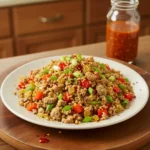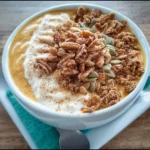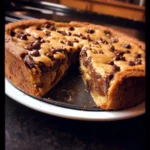Each year as Ostara approaches, I find myself drawn to recipes that feel both celebratory and grounding. This year, the seemingly paradoxical choice of leg of lamb for a spring festival intrigued me. Lamb often feels more like a hearty winter warmer, but the promise of spring onions and the vibrant flavors of garlic and red wine sparked my culinary curiosity. Let me tell you, this recipe was an absolute revelation. From the moment the lamb started roasting, filling my kitchen with an intoxicating aroma of garlic, herbs, and rich red wine, I knew we were in for something special. My family, usually a mixed bag of opinions when it comes to new dishes, unanimously declared this leg of lamb a new Ostara tradition. The meat was incredibly tender, practically falling off the bone, infused with a depth of flavor that only slow roasting can achieve. The butter-braised spring onions were the perfect accompaniment, adding a touch of sweetness and delicate oniony bite that cut through the richness of the lamb. Paired with a crisp pint of beer, as suggested, this meal truly felt like a celebration of spring’s bounty and the hearty flavors we crave as the days lengthen and the earth awakens. If you’re looking for an Ostara centerpiece that is both impressive and deeply satisfying, look no further. This Garlic & Red Wine Leg of Lamb is a kitchen magic spell waiting to be cast.
Ingredients: The Foundation of Flavor
The quality of your ingredients will significantly impact the final dish. For this Leg of Lamb recipe, we focus on fresh, robust flavors that complement each other beautifully. Don’t skimp on the garlic or the red wine – they are the heart and soul of this dish! And sourcing a good quality leg of lamb will make all the difference in tenderness and taste. Here’s what you’ll need:
For the Leg of Lamb:
- 1 Leg of Lamb: Approximately 5-7 pounds, bone-in or boneless (bone-in will generally be more flavorful and stay moister). Look for a leg of lamb that is well-marbled with fat for maximum flavor and tenderness. If possible, source lamb from a local butcher or farm for the best quality.
- 6-8 Cloves of Garlic: Fresh garlic is essential. Don’t use pre-minced garlic for this recipe; the robust flavor of freshly minced garlic is crucial. You’ll want large cloves if possible, and don’t be shy about adding a couple more if you are a garlic lover!
- 1 Bottle (750ml) Dry Red Wine: Choose a dry red wine that you enjoy drinking. A Cabernet Sauvignon, Merlot, or a Chianti Classico would work wonderfully. Avoid overly sweet wines. The red wine will braise the lamb, adding depth and richness to the sauce.
- 2 Tablespoons Sea Salt: Coarse sea salt is preferred for its pure flavor and texture. Kosher salt can be substituted. Salt is crucial for seasoning the lamb and drawing out its natural flavors.
- 1 Tablespoon Freshly Ground Black Pepper: Freshly ground black pepper offers a much more vibrant and aromatic flavor than pre-ground pepper.
- 2 Tablespoons Olive Oil: Extra virgin olive oil is recommended for its flavor and health benefits. It’s used for searing the lamb and adding richness to the braising liquid.
- 2 Sprigs Fresh Rosemary: Rosemary adds a classic, piney aroma that pairs beautifully with lamb. Fresh rosemary is far superior to dried in this recipe.
- 2 Sprigs Fresh Thyme: Thyme offers a slightly earthy and lemony flavor that complements the rosemary and garlic. Again, fresh thyme is highly recommended.
For the Butter-Braised Spring Onions:
- 2 Bunches Spring Onions: Choose fresh, firm spring onions. Look for bunches with bright green tops and white bulbs. Spring onions are milder than regular onions and offer a delicate sweetness that is perfect for spring.
- 4 Tablespoons Unsalted Butter: High-quality unsalted butter will provide the best flavor. Butter is essential for braising the spring onions and creating a rich, flavorful sauce.
- 1/4 Cup Chicken Broth (or Vegetable Broth): Low-sodium broth is recommended to control the saltiness. The broth helps to steam and braise the spring onions until tender.
- Salt and Pepper to taste: Season the spring onions to your preference.
Instructions: A Step-by-Step Guide to Lamb Perfection
This recipe is surprisingly straightforward, despite its impressive results. The key is patience and allowing the lamb to slowly roast and become incredibly tender. Follow these steps for a perfectly cooked and flavorful Leg of Lamb:
Preparing the Leg of Lamb:
- Preheat Your Oven: Preheat your oven to 325°F (160°C). This lower temperature is ideal for slow roasting, ensuring tender and juicy lamb.
- Prepare the Garlic: Peel and mince the garlic cloves finely. You can use a garlic press or mince them by hand. The finer the mince, the more the garlic flavor will infuse into the lamb.
- Season the Lamb: Pat the leg of lamb dry with paper towels. This helps to get a good sear. Generously rub the entire leg of lamb with sea salt and freshly ground black pepper. Be sure to season all sides, including the underside. Don’t be afraid to be generous with the seasoning, as a large cut of meat needs ample salt to bring out its flavor.
- Create Garlic Pockets: Using a sharp paring knife, make small incisions all over the leg of lamb, about 1-2 inches deep. Insert the minced garlic into these pockets, distributing it evenly across the lamb. This ensures that the garlic flavor penetrates deep into the meat as it roasts.
- Sear the Lamb (Optional but Recommended): Heat olive oil in a large Dutch oven or oven-safe roasting pan over medium-high heat. Searing the lamb before roasting adds a layer of flavor and helps to create a beautiful crust. Sear the leg of lamb on all sides until browned, about 2-3 minutes per side. This step is optional, but highly recommended for enhanced flavor and texture.
- Add Aromatics and Red Wine: Place the sprigs of rosemary and thyme around the leg of lamb in the roasting pan. Pour the entire bottle of red wine into the pan, around the lamb. The red wine will create a braising liquid as the lamb roasts, keeping it moist and infusing it with flavor.
Roasting the Leg of Lamb:
- Roast in the Oven: Cover the Dutch oven or roasting pan tightly with a lid or aluminum foil. Place it in the preheated oven and roast for approximately 3-4 hours, or until the lamb is fork-tender. The cooking time will depend on the size of your leg of lamb and whether it is bone-in or boneless. A bone-in leg may take slightly longer. The lamb is ready when it is easily pierced with a fork and the meat is pulling away from the bone (if bone-in).
- Check for Doneness: To check for doneness, insert a meat thermometer into the thickest part of the lamb, avoiding the bone. For medium-rare, aim for 135-140°F (57-60°C). For medium, aim for 140-145°F (60-63°C). For medium-well, aim for 145-150°F (63-66°C). Lamb is often best enjoyed medium-rare to medium, as it can become dry if overcooked.
- Rest the Lamb: Once the lamb is cooked to your desired doneness, remove it from the oven and carefully remove it from the roasting pan. Place the lamb on a cutting board and tent it loosely with aluminum foil. Let the lamb rest for at least 15-20 minutes before carving. Resting allows the juices to redistribute throughout the meat, resulting in a more tender and flavorful roast.
Making the Butter-Braised Spring Onions:
- Prepare the Spring Onions: While the lamb is resting, prepare the spring onions. Trim the roots from the spring onions and remove any wilted or damaged outer layers. Cut the spring onions into roughly 2-inch lengths, keeping the white and green parts separate for now if you prefer a more delicate braise for the greens (though you can braise them all together).
- Braise the Spring Onions: In a large skillet or pan, melt the butter over medium heat. Add the white parts of the spring onions (and the green parts if braising together) and cook for 2-3 minutes, until slightly softened.
- Add Broth and Simmer: Pour in the chicken broth (or vegetable broth) and bring to a simmer. Reduce the heat to low, cover the pan, and braise the spring onions for 10-15 minutes, or until they are tender-crisp and have absorbed some of the broth. If you separated the green parts, add them in the last 5 minutes of braising to keep them bright green.
- Season and Serve: Season the braised spring onions with salt and pepper to taste.
Carving and Serving:
- Carve the Lamb: After the lamb has rested, carve it against the grain into slices. If you have a bone-in leg, carve around the bone first to remove the meat.
- Serve and Enjoy: Arrange the sliced leg of lamb on a platter and spoon the braised spring onions and the red wine braising juices from the roasting pan over the lamb. Serve immediately and enjoy your delicious Ostara feast!
Nutrition Facts: A Hearty and Wholesome Meal
(Please note: Nutritional information is an estimate and can vary based on specific ingredients and serving sizes. It is always best to use a nutrition calculator for precise values.)
Servings: Approximately 8-10 servings
Estimated Calories per Serving: 600-800 calories (This is an approximation and depends on serving size, fat content of the lamb, and added sides.)
Approximate Macronutrient Breakdown per Serving (Estimate):
- Protein: 50-60 grams
- Fat: 30-50 grams (depending on the cut and fat trimming)
- Carbohydrates: 5-10 grams (primarily from wine and spring onions)
Key Nutritional Highlights:
- High in Protein: Lamb is an excellent source of high-quality protein, essential for muscle building and repair, as well as overall bodily functions.
- Rich in Iron and Vitamin B12: Lamb is a good source of iron, important for preventing anemia, and Vitamin B12, crucial for nerve function and red blood cell formation.
- Contains Healthy Fats: While lamb does contain fat, it also includes healthy fats like omega-3 fatty acids, which are beneficial for heart health.
- Garlic and Spring Onions are Nutrient-Rich: Garlic is known for its immune-boosting properties and is a source of antioxidants. Spring onions are a good source of Vitamin C and fiber.
- Red Wine Antioxidants: Red wine contains antioxidants, particularly resveratrol, which may have health benefits when consumed in moderation.
Preparation Time: Plan Ahead for Flavor
This recipe requires a bit of time, but most of it is hands-off roasting time. Planning ahead will make the process smooth and enjoyable.
- Prep Time: 30-40 minutes (This includes mincing garlic, seasoning lamb, preparing spring onions, and searing – if searing.)
- Cook Time: 3-4 hours for the Leg of Lamb, 15-20 minutes for the Butter-Braised Spring Onions.
- Resting Time: 15-20 minutes for the Leg of Lamb.
- Total Time: Approximately 4-5 hours (including resting).
Tips for Time Management:
- You can prepare the lamb (season and garlic pockets) the day before and store it in the refrigerator overnight. This allows the flavors to meld even further.
- Start roasting the lamb well in advance of your desired serving time, allowing ample time for slow roasting and resting.
- Prepare the spring onions while the lamb is resting, or shortly before serving. They are quick to braise.
How to Serve: Completing Your Ostara Feast
Leg of lamb is a versatile dish that pairs beautifully with a variety of sides. For an Ostara celebration, consider these serving suggestions:
- Essential Pairing:
- Butter-Braised Spring Onions: As featured in this recipe, they are a must-have accompaniment.
- Classic Side Dishes:
- Roasted Root Vegetables: Carrots, parsnips, potatoes, and sweet potatoes roasted with herbs like rosemary and thyme complement the lamb beautifully.
- Creamy Mashed Potatoes: A comforting and classic side that soaks up the delicious red wine sauce.
- Garlic Roasted Potatoes: Enhance the garlic theme with roasted potatoes tossed in garlic and herbs.
- Green Beans Almondine: A fresh and vibrant green vegetable side dish.
- Asparagus with Lemon: Another spring vegetable that pairs well with lamb and adds brightness.
- Fresh and Lighter Options:
- Spring Salad with Vinaigrette: A light and refreshing salad with seasonal greens, radishes, and a bright vinaigrette.
- Mint Sauce or Gremolata: A traditional mint sauce or a vibrant gremolata (parsley, garlic, lemon zest) can cut through the richness of the lamb and add a fresh element.
- Bread and Drinks:
- Crusty Bread: Serve with crusty bread for soaking up the delicious red wine sauce.
- Red Wine (same as used for cooking): Pair with the same red wine you used in the recipe for a cohesive flavor profile.
- Pint of Beer (as recommended): A crisp, cold beer, like a pale ale or lager, can be a surprisingly refreshing pairing with lamb.
Additional Tips for Leg of Lamb Success
- Choose the Right Cut: Bone-in leg of lamb is generally more flavorful and stays moister than boneless. If you choose boneless, ensure it is securely tied to maintain its shape during roasting.
- Don’t Skip the Searing (If You Can): Searing the lamb before roasting creates a beautiful crust and adds depth of flavor. It’s a worthwhile step if you have the time.
- Rest is Key: Resting the lamb after roasting is absolutely crucial for tender and juicy meat. Don’t be tempted to carve it immediately. Allow at least 15-20 minutes for the juices to redistribute.
- Baste for Extra Moisture (Optional): While not strictly necessary with slow roasting and braising in red wine, you can baste the lamb with the pan juices every hour or so during roasting for extra moisture and flavor.
- Carve Against the Grain: Always carve meat against the grain for maximum tenderness. Identify the direction of the muscle fibers and slice perpendicular to them.
FAQ: Your Leg of Lamb Questions Answered
Q1: Can I use a different type of red wine?
A: Yes, you can. While dry red wines like Cabernet Sauvignon, Merlot, or Chianti Classico are recommended, you can also use other dry red wines you enjoy, such as Pinot Noir or a Côtes du Rhône. Avoid overly sweet or fruity wines.
Q2: What if I don’t have fresh rosemary and thyme? Can I use dried herbs?
A: Fresh herbs are highly recommended for the best flavor, but in a pinch, you can use dried herbs. Use about 1 teaspoon of dried rosemary and 1 teaspoon of dried thyme as substitutes for the fresh sprigs. However, the flavor will be more intense with dried herbs, so use them sparingly.
Q3: How do I know when the lamb is cooked to the right temperature without a meat thermometer?
A: While a meat thermometer is the most accurate way to check for doneness, you can also use the fork-tenderness test. Insert a fork into the thickest part of the lamb. If it pierces easily and the meat is pulling away from the bone (if bone-in), it is likely cooked. However, for precise doneness, a meat thermometer is always recommended.
Q4: Can I make this recipe ahead of time?
A: You can prepare the lamb up to a day ahead of time by seasoning it and inserting the garlic. Store it covered in the refrigerator. You can also roast the lamb ahead of time and reheat it. To reheat, slice the lamb and gently warm it in the red wine braising juices in a covered pan in the oven or on the stovetop until heated through. Be careful not to overheat, or the lamb may become dry. The spring onions are best made fresh just before serving.
Q5: What can I do with leftover leg of lamb?
A: Leftover leg of lamb is incredibly versatile! You can use it for:
- Lamb Sandwiches: Slice or shred the lamb and make delicious sandwiches with your favorite bread, toppings, and sauces.
- Lamb Shepherd’s Pie: Use leftover lamb in a hearty shepherd’s pie.
- Lamb Curry or Stew: Add diced lamb to curries or stews for added protein and flavor.
- Lamb Salad: Shredded lamb can be added to salads for a protein boost.
- Lamb Tacos or Wraps: Use shredded lamb in tacos or wraps with your favorite fillings.
Enjoy your Ostara Leg of Lamb feast! May this hearty and flavorful dish bring warmth and abundance to your spring celebrations.
Print
Leg of Lamb Recipe
Ingredients
For the Leg of Lamb:
- 1 Leg of Lamb: Approximately 5-7 pounds, bone-in or boneless (bone-in will generally be more flavorful and stay moister). Look for a leg of lamb that is well-marbled with fat for maximum flavor and tenderness. If possible, source lamb from a local butcher or farm for the best quality.
- 6–8 Cloves of Garlic: Fresh garlic is essential. Don’t use pre-minced garlic for this recipe; the robust flavor of freshly minced garlic is crucial. You’ll want large cloves if possible, and don’t be shy about adding a couple more if you are a garlic lover!
- 1 Bottle (750ml) Dry Red Wine: Choose a dry red wine that you enjoy drinking. A Cabernet Sauvignon, Merlot, or a Chianti Classico would work wonderfully. Avoid overly sweet wines. The red wine will braise the lamb, adding depth and richness to the sauce.
- 2 Tablespoons Sea Salt: Coarse sea salt is preferred for its pure flavor and texture. Kosher salt can be substituted. Salt is crucial for seasoning the lamb and drawing out its natural flavors.
- 1 Tablespoon Freshly Ground Black Pepper: Freshly ground black pepper offers a much more vibrant and aromatic flavor than pre-ground pepper.
- 2 Tablespoons Olive Oil: Extra virgin olive oil is recommended for its flavor and health benefits. It’s used for searing the lamb and adding richness to the braising liquid.
- 2 Sprigs Fresh Rosemary: Rosemary adds a classic, piney aroma that pairs beautifully with lamb. Fresh rosemary is far superior to dried in this recipe.
- 2 Sprigs Fresh Thyme: Thyme offers a slightly earthy and lemony flavor that complements the rosemary and garlic. Again, fresh thyme is highly recommended.
For the Butter-Braised Spring Onions:
- 2 Bunches Spring Onions: Choose fresh, firm spring onions. Look for bunches with bright green tops and white bulbs. Spring onions are milder than regular onions and offer a delicate sweetness that is perfect for spring.
- 4 Tablespoons Unsalted Butter: High-quality unsalted butter will provide the best flavor. Butter is essential for braising the spring onions and creating a rich, flavorful sauce.
- 1/4 Cup Chicken Broth (or Vegetable Broth): Low-sodium broth is recommended to control the saltiness. The broth helps to steam and braise the spring onions until tender.
- Salt and Pepper to taste: Season the spring onions to your preference.
Instructions
Preparing the Leg of Lamb:
- Preheat Your Oven: Preheat your oven to 325°F (160°C). This lower temperature is ideal for slow roasting, ensuring tender and juicy lamb.
- Prepare the Garlic: Peel and mince the garlic cloves finely. You can use a garlic press or mince them by hand. The finer the mince, the more the garlic flavor will infuse into the lamb.
- Season the Lamb: Pat the leg of lamb dry with paper towels. This helps to get a good sear. Generously rub the entire leg of lamb with sea salt and freshly ground black pepper. Be sure to season all sides, including the underside. Don’t be afraid to be generous with the seasoning, as a large cut of meat needs ample salt to bring out its flavor.
- Create Garlic Pockets: Using a sharp paring knife, make small incisions all over the leg of lamb, about 1-2 inches deep. Insert the minced garlic into these pockets, distributing it evenly across the lamb. This ensures that the garlic flavor penetrates deep into the meat as it roasts.
- Sear the Lamb (Optional but Recommended): Heat olive oil in a large Dutch oven or oven-safe roasting pan over medium-high heat. Searing the lamb before roasting adds a layer of flavor and helps to create a beautiful crust. Sear the leg of lamb on all sides until browned, about 2-3 minutes per side. This step is optional, but highly recommended for enhanced flavor and texture.
- Add Aromatics and Red Wine: Place the sprigs of rosemary and thyme around the leg of lamb in the roasting pan. Pour the entire bottle of red wine into the pan, around the lamb. The red wine will create a braising liquid as the lamb roasts, keeping it moist and infusing it with flavor.
Roasting the Leg of Lamb:
- Roast in the Oven: Cover the Dutch oven or roasting pan tightly with a lid or aluminum foil. Place it in the preheated oven and roast for approximately 3-4 hours, or until the lamb is fork-tender. The cooking time will depend on the size of your leg of lamb and whether it is bone-in or boneless. A bone-in leg may take slightly longer. The lamb is ready when it is easily pierced with a fork and the meat is pulling away from the bone (if bone-in).
- Check for Doneness: To check for doneness, insert a meat thermometer into the thickest part of the lamb, avoiding the bone. For medium-rare, aim for 135-140°F (57-60°C). For medium, aim for 140-145°F (60-63°C). For medium-well, aim for 145-150°F (63-66°C). Lamb is often best enjoyed medium-rare to medium, as it can become dry if overcooked.
- Rest the Lamb: Once the lamb is cooked to your desired doneness, remove it from the oven and carefully remove it from the roasting pan. Place the lamb on a cutting board and tent it loosely with aluminum foil. Let the lamb rest for at least 15-20 minutes before carving. Resting allows the juices to redistribute throughout the meat, resulting in a more tender and flavorful roast.
Making the Butter-Braised Spring Onions:
- Prepare the Spring Onions: While the lamb is resting, prepare the spring onions. Trim the roots from the spring onions and remove any wilted or damaged outer layers. Cut the spring onions into roughly 2-inch lengths, keeping the white and green parts separate for now if you prefer a more delicate braise for the greens (though you can braise them all together).
- Braise the Spring Onions: In a large skillet or pan, melt the butter over medium heat. Add the white parts of the spring onions (and the green parts if braising together) and cook for 2-3 minutes, until slightly softened.
- Add Broth and Simmer: Pour in the chicken broth (or vegetable broth) and bring to a simmer. Reduce the heat to low, cover the pan, and braise the spring onions for 10-15 minutes, or until they are tender-crisp and have absorbed some of the broth. If you separated the green parts, add them in the last 5 minutes of braising to keep them bright green.
- Season and Serve: Season the braised spring onions with salt and pepper to taste.
Carving and Serving:
- Carve the Lamb: After the lamb has rested, carve it against the grain into slices. If you have a bone-in leg, carve around the bone first to remove the meat.
- Serve and Enjoy: Arrange the sliced leg of lamb on a platter and spoon the braised spring onions and the red wine braising juices from the roasting pan over the lamb. Serve immediately and enjoy your delicious Ostara feast!
Nutrition
- Serving Size: One Normal Portion
- Calories: 600-800
- Fat: 30-50 grams
- Carbohydrates: 5-10 grams
- Protein: 50-60 grams





